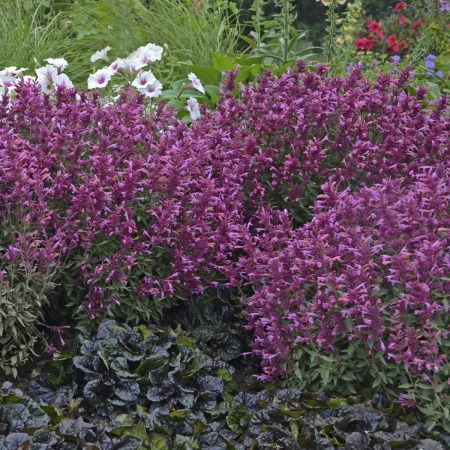Agastache (Hyssop-Anise)
×
Color Name: Rosie Posie
One of the easiest and most rewarding perennials to grow! Rosie Posie bears loads of hot pink flowers with magenta purple calyxes just at the top of the foliage for a neatly proportional look. Because the calyxes are so colorful, this plant continues to look like it is blooming long after it is finished. The bottlebrush-like flowers, on strong, upright stems, bloom from midsummer to early fall. It is useful for adding a spot of color to the garden late in the season when many other plants are finished. Its foliage smells distinctly like black licorice when crushed, thus its common name, Anise Hyssop.
Agastache is well-adapted to thrive in dry soils and is right at home in rock gardens where it will attract hummingbirds, butterflies and honeybees.
Growing Tips: Agastache should be planted in full sun and slightly alkaline soil. The most critical factor is good drainage. This plant will NOT tolerate wet soil, especially in winter. When planting, put a thick layer of gravel in the bottom of the hole and then mix more in with the filler soil. Native to the southwest US and Mexico, it is naturally heat and drought tolerant.
Photo courtesy of Walters Garden, Inc.
One of the easiest and most rewarding perennials to grow! Rosie Posie bears loads of hot pink flowers with magenta purple calyxes just at the top of the foliage for a neatly proportional look. Because the calyxes are so colorful, this plant continues to look like it is blooming long after it is finished. The bottlebrush-like flowers, on strong, upright stems, bloom from midsummer to early fall. It is useful for adding a spot of color to the garden late in the season when many other plants are finished. Its foliage smells distinctly like black licorice when crushed, thus its common name, Anise Hyssop.
Agastache is well-adapted to thrive in dry soils and is right at home in rock gardens where it will attract hummingbirds, butterflies and honeybees.
Growing Tips: Agastache should be planted in full sun and slightly alkaline soil. The most critical factor is good drainage. This plant will NOT tolerate wet soil, especially in winter. When planting, put a thick layer of gravel in the bottom of the hole and then mix more in with the filler soil. Native to the southwest US and Mexico, it is naturally heat and drought tolerant.
Photo courtesy of Walters Garden, Inc.
|
Flower Color: Pink Shades Foliage Color: Green Shades
Height: 18 to 22 Inches Spread: 24 to 30 Inches Hardy in Zone: 4, 5, 6 |
Blooms: Summer to Fall
Foliage Season: All Season |
Growth Rate |
Medium
|
Attributes |
Fragrant Extended Bloomer Dried Flower Native Mass Planting Landscapes Easy to Grow Drought Tolerant Cut Flower or Foilage Border
|









